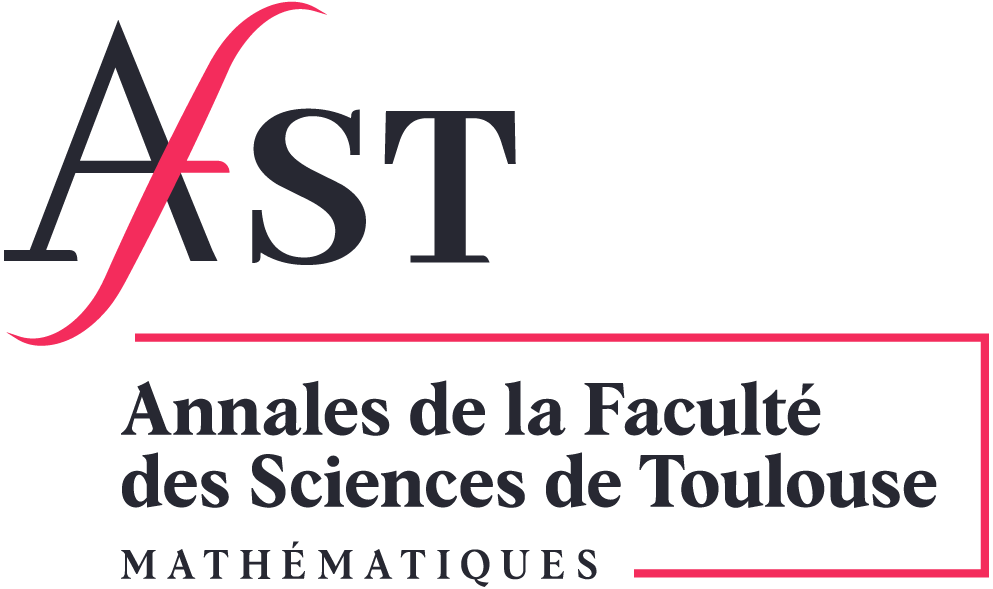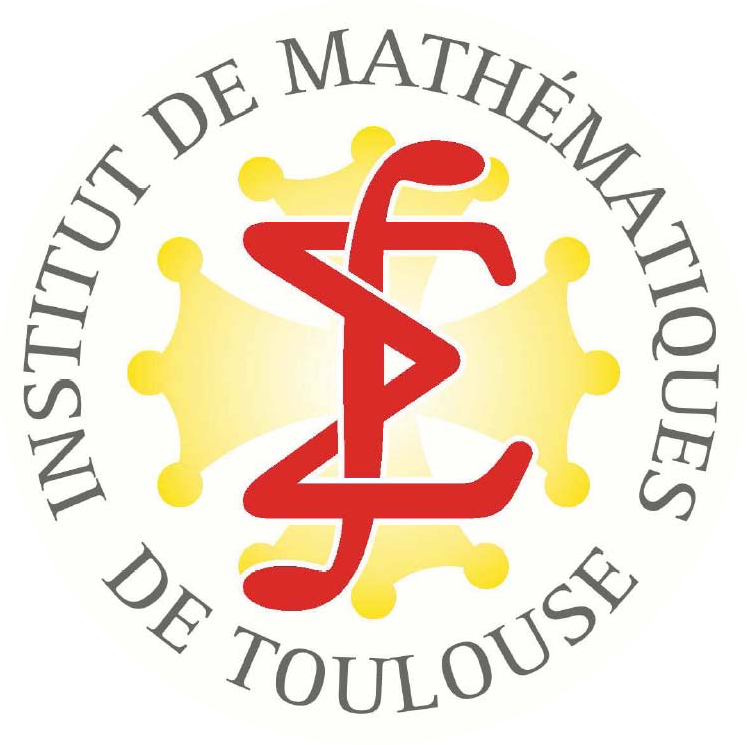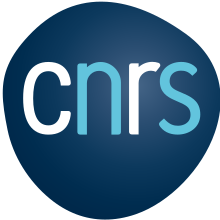This paper discusses some mathematical aspects related to the use of probabilistic techniques in quantum Monte Carlo (QMC) methods from a physicist’s point of view. A selected list of problems and techniques employed in computational physics and of interest to the applied probability community is presented. One of the variants of QMC approaches based on the Feynman-Kac formula is described in some detail. The problem of numerical efficiency at the heart of physical applications defined in (very) high-dimensional space is discussed and the commonly used solution through importance sampling is presented. Finally, the specific constraints related to fermion systems in QMC are presented and the celebrated “fermion sign problem” (considered as one of the most important open problem in computational physics) is discussed.
Dans cet article nous discutons quelques aspects mathématiques des méthodes Monte Carlo quantique du point de vue du physicien. Une liste (non-exhaustive) de techniques probabilistes utilisées et développées en physique et de problèmes ouverts est présentée. Afin d’illuster l’approche des physiciens, nous décrivons en détail une des variantes des méthodes Monte Carlo quantique basée sur la formule de Feynman-Kac. Le problème de l’efficacité numérique au cœur des applications physiques où l’espace de configuration est en général de très grande dimension est présenté, ainsi que la solution adoptée. Finalement, nous explicitons les contraintes spécifiques associées à la simulation des systèmes de fermions et présentons le fameux “problème du signe” considéré comme un des problèmes les plus importants à résoudre en physique numérique.
@article{AFST_2015_6_24_4_949_0,
author = {Michel Caffarel},
title = {Talking {Across} {Fields:} {A} {Physicist{\textquoteright}s} {Presentation} of some {Mathematical} {Aspects} of {Quantum} {Monte} {Carlo} {Methods}},
journal = {Annales de la Facult\'e des sciences de Toulouse : Math\'ematiques},
pages = {949--972},
publisher = {Universit\'e Paul Sabatier, Institut de Math\'ematiques},
address = {Toulouse},
volume = {Ser. 6, 24},
number = {4},
year = {2015},
doi = {10.5802/afst.1471},
zbl = {1331.81037},
language = {en},
url = {https://afst.centre-mersenne.org/articles/10.5802/afst.1471/}
}
TY - JOUR AU - Michel Caffarel TI - Talking Across Fields: A Physicist’s Presentation of some Mathematical Aspects of Quantum Monte Carlo Methods JO - Annales de la Faculté des sciences de Toulouse : Mathématiques PY - 2015 SP - 949 EP - 972 VL - 24 IS - 4 PB - Université Paul Sabatier, Institut de Mathématiques PP - Toulouse UR - https://afst.centre-mersenne.org/articles/10.5802/afst.1471/ DO - 10.5802/afst.1471 LA - en ID - AFST_2015_6_24_4_949_0 ER -
%0 Journal Article %A Michel Caffarel %T Talking Across Fields: A Physicist’s Presentation of some Mathematical Aspects of Quantum Monte Carlo Methods %J Annales de la Faculté des sciences de Toulouse : Mathématiques %D 2015 %P 949-972 %V 24 %N 4 %I Université Paul Sabatier, Institut de Mathématiques %C Toulouse %U https://afst.centre-mersenne.org/articles/10.5802/afst.1471/ %R 10.5802/afst.1471 %G en %F AFST_2015_6_24_4_949_0
Michel Caffarel. Talking Across Fields: A Physicist’s Presentation of some Mathematical Aspects of Quantum Monte Carlo Methods. Annales de la Faculté des sciences de Toulouse : Mathématiques, Série 6, Numéro Spécial : Conférence “Talking Across Fields” du 24 au 28 mars 2014 à l’Institut de Mathématiques de Toulouse, Tome 24 (2015) no. 4, pp. 949-972. doi : 10.5802/afst.1471. https://afst.centre-mersenne.org/articles/10.5802/afst.1471/
[1] Al-Saidi (W. A.), Zhang (S.), and Krakauer (H.).— Auxiliary-field quantum Monte Carlo calculations of molecular systems with a Gaussian basis J. Chem. Phys. 124, 224101 (2006).
[2] Anderson (J.).— A Random-Walk Simulation of the Schrödinger Equation: H, J. Chem. Phys. 63, 1499 (1975).
[3] Anderson (A. G.) and Goddard III (W.A.) .— Generalized valence bond wave functions in quantum Monte Carlo J. Chem. Phys. 132 164110, (2010).
[4] Assaraf (R.), Caffarel (M.), and Khelif (A.).— Diffusion Monte Carlo methods with a fixed number of walkers Phys. Rev. E 61 4566 (2000).
[5] Assaraf (R.), Caffarel (M.), and Khelif (A.).— The Fermion Monte Carlo Revisited J. Phys. A : Math. Theor. 40, 1181 (2007). | MR | Zbl
[6] Assaraf (R.) and Caffarel (M.).— Zero-variance principle for Monte Carlo algorithms Phys. Rev. Lett. 83, 4682 (1999).
[7] Assaraf (R.) and Caffarel (M.).— Computing forces with quantum Monte Carlo J. Chem. Phys. 113,4028 (2000).
[8] Assaraf (R.) and Caffarel (M.).— Zero-Variance Zero-Bias Principle for Observables in quantum Monte Carlo: Application to Forces J. Chem. Phys. 119, 10536 (2003).
[9] Assaraf (R.), Caffarel (M.), and Scemama (A.).— Improved Monte Carlo estimators for the one-body density Phys. Rev. E 75, 035701 (2007).
[10] Assaraf (R.), Caffarel (M.), and Kollias (A.).— Chaotic versus Nonchaotic Stochastic Dynamics in Monte Carlo Simulations: A Route for Accurate Energy Differences of N-body systems Phys. Rev. Letters 106, 150601 (2011).
[11] Badinski (A.), Trail (J. R.) and Needs (R. J.).— Energy derivatives in quantum Monte Carlo involving the zero-variance property J. Chem. Phys. 129, 224101 (2008).
[12] Bajdich (M.), Mitáš (L.), Drobnỳ (G.), Wagner (L.K.), and Schmidt (K.E.).— Pfaffian Pairing Wave Functions in Electronic-Structure Quantum Monte Carlo Simulations Phys. Rev. Lett. 96, 130201 (2006).
[13] Bakhturin (Y. A.).— Campbell-Hausdorff formula, in Hazewinkel Michiel, Encyclopaedia of Mathematics, Springer (2001). | Zbl
[14] Baroni (S.) and Moroni (S.).— Reptation Quantum Monte Carlo: A Method for Unbiased Ground-State Averages and Imaginary-Time Correlations Phys. Rev. Lett. 82, 4745 (1999).
[15] Braıida (B.), Toulouse (J.), Caffarel (M.), and Umrigar (C.J.).— Quantum Monte Carlo with Jastrow Valence-Bond wave functions: application to bond breaking of some first-row diatomic molecules J. Chem. Phys., 134 0184108, (2011).
[16] Booth (G.H.), Thom (A.J.W.), and Alavi (A.).— Fermion Monte Carlo without fixed nodes: a Game of Life, death and annihilation in Slater Determinant space J. Chem. Phys. 131, 054106, (2009).
[17] Bouabça (T.), Braîda (B.), and Caffarel (M.).— Multi-Jastrow trial wavefunctions for electronic structure calculations with quantum Monte Carlo J. Chem. Phys., 133 044111, (2010).
[18] Caffarel (M.) and Claverie (P.).— Development of a pure diffusion quantum Monte Carlo method using a full generalized Feynman-Kac formula. I. Formalism J. Chem. Phys. 88, 1088 (1988). | MR
[19] Caffarel (M.), Krokidis (X.), and Mijoule (C.).— On the Nonconservation of the Number of Nodel Cells of Eigenfunctions Europhys. Lett. 20, 581 (1992).
[20] Caffarel (M.) and Ceperley (D.M.).— A Bayesian Analysis of Green’s Function Monte Carlo Correlation Functions J. Chem. Phys. 97, 8415 (1992).
[21] Casula (M.), Attaccalite (C.), and Sorella (S.).— Correlated geminal wave function for molecules: An efficient resonating valence bond approach J. Chem. Phys., 121 7110, (2004).
[22] Cancès (E.), Jourdain (B.) and Lelièvre (T.).— Quantum Monte-Carlo simulations of fermions. A mathematical analysis of the fixed-node approximation. Math. Mod. Meth. Appl. Sci. 16 p. 1403-1440 (2006). | MR | Zbl
[23] Ceperley (D.M.).— Path Integrals in the Theory of Condensed Helium Rev. Mod. Phys. 67, 279 (1995).
[24] Ceperley (D.M.), Chester (G.V.), and Kalos (M.H.).— Monte Carlo Simulation of a Many-Fermion System, Phys. Rev. B 16, 3081 (1977).
[25] Ceperley (D.M.) Alder (B.J.).— Quantum Monte Carlo for Molecules: Green’s Function and Nodal Release, J. Chem. Phys. 81, 5833 (1984).
[26] Ceperley (D.M.).— Fermion nodes J. Stat. Phys. 63 p. 1237-1267 (1991).
[27] Ceperley (D.M.) and Alder (B.J.).— Ground State of the Electron Gas by a Stochastic Method Phys. Rev. Lett. 45, 566 (1980).
[28] Cleland (D.), Booth (G.H.), and Alavi (A.).— Survival of the Fittest: Accelerating Convergence in Full Configuration-Interaction Quantum Monte Carlo J. Chem. Phys., 132, 041103, (2010).
[29] Dalla Valle (L.), and Leisen (F.).— A new multinomial model and a zero variance estimation, Comm. Statist. Simulation Comput. 39 846-859 (2010). | MR | Zbl
[30] del Moral (P.).— Feynman-Kac Formulae. Genealogical and Interacting Particle Systems with Applications., Springer, New York; Series: Probability and Applications (2004). | MR | Zbl
[31] Feynman (R.P.).— Space-Time Approach to Non-Relativistic Quantum Mechanics, Rev. of Mod. Phys. 20 (2) 367 (1948). | MR
[32] Feynman (R.P.) and Hibbs (A.R.).— Quantum Mechanics and Path Integrals McGraw-Hill, New York, (1965). | Zbl
[33] Filippi (C.) and Umrigar (C.J.).— Correlated sampling in quantum Monte Carlo: A route to forces Phys. Rev. B 61 16291-4 (2000).
[34] Filippi (C.) and Umrigar (C.J.).— Multiconfiguration wave functions for quantum Monte Carlo calculations of first-row diatomic molecules J. Chem. Phys., 105 213, (1996).
[35] Foulkes (W.M.C.), Litas (L.), Needs (R.G.), and Rajagopal (G.).— Quantum Monte Carlo simulations of Solids Rev. Mod. Phys. 73, 33 (2001).
[36] Fracchia (F.), Filippi (C.), and Amovilli (C.).— Size-extensive wave functions for quantum Monte Carlo: A linear scaling generalized valence bond approach J. Chem. Theory Comput. 8, 1943 (2012).
[37] Friel (N.), Mira (A.), and Oates (C.J.).— Exploiting Multi-Core Architectures for Reduced-Variance Estimation with Intractable Likelihoods, Bayesian Analysis (2015).
[38] Fulton (W.).— Young Tableaux With Applications to Representation Theory and Geometry, London Mathematical Society Student Texts 35, Cambridge University Press (1997). | MR | Zbl
[39] Giner (E.), Scemama (A.), and Caffarel (M.).— Using perturbatively selected configuration interaction in quantum Monte Carlo calculations Can. J. Chem. 91, 879 (2013).
[40] Glimm (J.) and Jaffe (A.).— Quantum Physics. A Functional Integral Point of View Springer-Verlag, 2 edition New York (1987). | MR | Zbl
[41] Grimm (R.C.) and Storer (R.G.).— Monte-Carlo solution of Schrödinger’s equation J. Comput. Phys. 7, 134 (1971). | MR
[42] Gubematis (J.E.), Jarrell (M.), Silver (R.N.), and Sivia (D.S.).— Quantum Monte Carlo simulations and maximum entropy: Dynamics from imaginary-time data Phys. Rev. B 44, 6011 (1991).
[43] Harju (A.), Barbiellini (B.), Siljamäki (S.), Nieminen (R.M.), and Ortiz (G.).— Stochastic Gradient Approximation: An Efficient Method to Optimize Many-Body Wave Functions Phys. Rev. Lett. 79, 1173 (1997).
[44] Hastings (W.K.) (1970).— Monte Carlo Sampling Methods Using Markov Chains and Their Applications Biometrika 57(1) p.97-109 (1970). | Zbl
[45] Hetherington (J.H.).— Observations on the statistical iteration of matrices Phys. Rev. A 30, 2713 (1984). | MR
[46] Kalos (M.H.) and Pederiva (F.).— Exact Monte Carlo method for continuum fermion systems Phys. Rev. Lett. 85 3547 (2000).
[47] Kato (T.).— Fundamental Properties of Hamiltonian Operators of Schrödinger Type Trans. Amer. math. Soc. 70, p.195-211 (1951). | MR | Zbl
[48] Khasminskii (R.Z.).— Ergodic Properties of Recurrent Diffusion Processes and Stabilization of the Solution to the Cauchy Problem for Parabolic EquationsTheory Probab. Appl., 5(2), 179-196 (1960). | MR | Zbl
[49] Klein (D.J.) and Pickett (H.M.).— Nodal Hypersurfaces and Anderson’s Random-Walk Simulation of the Schroedinger Equation J. Chem. Phys. 64 4811 (1976).
[50] Krein (M.G.) and Rutman (M.A.).— Linear operators leaving invariant a cone in a Banach space (Russian), Uspehi Mat. Nauk 3, No. 1, 23 p.3-95 (1948). | MR | Zbl
[51] Loh Jr. (E.Y.), Gubernatis (J.E.), Scalettar (R.T.), White (S.R.), Scalapino (D.J.), and Sugar (R.).— Sign problem in the numerical simulation of many-electron systems Phys. Rev. B 41, 9301 (1990).
[52] Lopez Rios (P.), Ma (A.), Drummond (N.D.), Towler (M.D.), and Needs (R.J.).— Inhomogeneous backflow transformations in Quantum Monte Carlo Phys. Rev. E, 74 066701, (2006).
[53] Matsen (F. A.).— Spin-free quantum chemistry Adv. Quantum Chem. , 59 (1964).
[54] Metropolis (N.), Rosenbluth (A.W.), Rosenbluth (N.M.), Teller (A.H.), and Teller (E.).— Equations of State Calculations by Fast Computing Machines J. Chem. Phys. 21 1087-1092 (1953).
[55] Mira (A.), Solgi (R.), and Imparato (D.).— Zero variance Markov chain Monte Carlo for Bayesian estimators, Statistics and Computing Vol. 23(5) Sep 1 (2013). | MR
[56] Oates (C.J.), Papamarkou (T.), and Girolami (M.).— The controlled thermodynamic integral for Bayesian model evidence evaluation, Journal of the American Statistical Association, just-accepted (2015).
[57] Papamarkou (T.), Mira (A.), and Girolami (M.).— Zero Variance Differential Geometric Markov Chain Monte Carlo Algorithms, Bayesian Analysis Vol. 9(1) 97–128 (2014). | MR
[58] Papoulis (A.).— Probability, Random Variables, and Stochastic Processes 2nd ed. New York: McGraw-Hill (1984). | MR | Zbl
[59] Reynolds (P.J.), Ceperley (D.M.), Alder (B.J.), and Lester Jr. (W.A.).— Fixed-node Quantum Monte Carlo for Molecules, J. Chem. Phys. 77, 5593 (1982).
[60] Rousset (M.).— On a probabilistic interpretation of shape derivatives of Dirichlet groundstates with application to fermion nodesESAIM: Mathematical Modelling and Numerical Analysis 44 Issue: 5 p.977-995 (2010) | EuDML | Numdam | MR | Zbl
[61] Scemama (A.), Lelièvre (T.), Stoltz (G.), Cancès (E.), and Caffarel (M.),An efficient sampling algorithm for Variational Monte Carlo J. Chem. Phys. 125, 114105 (2006).
[62] Schmidt (K.E.) and Moskowitz (J.W.).— Correlated Monte Carlo wave functions for the atoms He through Ne J. Chem. Phys., 93 4172, (1990).
[63] Schmidt (K.E.) and Kalos (M.H.), in K. Binder (ed.):.— Applications of the Monte Carlo Method in Statistical Physics (Springer, 1984). | Zbl
[64] Sorella (S.) and Capriotti (L.).— Green function Monte Carlo with stochastic reconfiguration: An effective remedy for the sign problem Phys. Rev. B 61 2599 (2000).
[65] Sorella (S.).— Generalized Lanczos algorithm for variational quantum Monte Carlo Phys. Rev. B 64, 024512 (2001).
[66] Troyer (M.), Wiese (U.-J.).— Computational complexity and fundamental limitations to fermionic quantum Monte Carlo simulations, Phys. Rev. Lett. 94, 170201 (2005).
[67] Umrigar (C.J.), Wilson (K.G.), and Wilkins (J.W.).— Optimized trial wave functions for quantum Monte Carlo calculations Phys. Rev. Lett. 60 p.1719-22 (1988).
[68] Umrigar (C.J.), Toulouse (J.), Filippi (C.), Sorella (S.) and Hennig (R. G.).— Alleviation of the Fermion-Sign Problem by Optimization of Many-Body Wave Functions Phys. Rev. Lett. 98, 110201 (2007).
[69] Wigner (E. P.).— Group Theory and its application to the quantum mechanics of atomic spectra Academic Press Inc. New York (1959). | MR | Zbl
[70] Zhang (S.), Carlson (J.), and Gubernatis (J.E.).— Constrained path Monte Carlo method for fermion ground states Phys. Rev. B 55, 7464 (1997).
[71] Zhang (S.).— Constrained path Monte Carlo for fermionsin M.P. Nightingale and Umrigar (C.J.) (eds.): Quantum Monte Carlo Methods in Physics and Chemistry, Kluwer Dordrecht, (1999).
[72] Zhang (S.) and Krakauer (H.).— Quantum Monte Carlo method using phase-free random walks with Slater determinants Phys. Rev. Lett. 90, 136401 (2003).
Cité par Sources :




